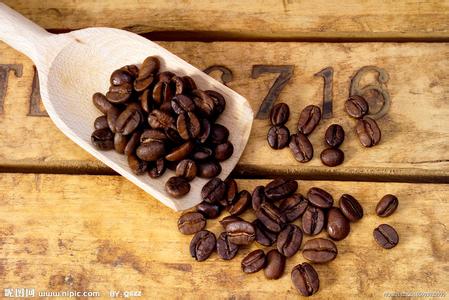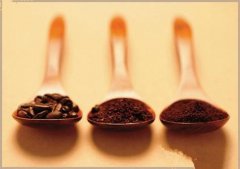A coffee tree can produce about 3-5 kg of coffee cherries.

A coffee tree can bear about 3-5 kilograms of coffee cherries and can be refined into 1/5 weight raw coffee beans. Among them, through the hands and time of many people, coffee cherries are transformed into raw coffee beans.
Arabica species and Robusta species
Arabica accounts for about 2/3 of the world's coffee production, so it is not suitable to grow in areas with high temperature, low temperature, more rain and less rain. The beans are oval shoulder flat, characterized by strong fragrance and good quality.
Robusta is bitter but not sour, and the flavor is not very good, so it is suitable for making mixed-flavor coffee. Mixed with the right amount of robusta in Arabica, it is usually used to make iced coffee, instant coffee and canned coffee. It is characterized by growing in lowlands. Strong disease resistance.
The quality and output of Liberika species are not good. Most of them are exported to Europe, but not imported to Japan.
Flat beans and round beans
Ripe and red coffee cherries have multiple structures. In the middle is the predecessor of the coffee bean, the light green seed. Generally speaking, the fruit of coffee is made up of two oval seeds opposite each other. The side that connects with each other is a flat joint, so it is called flat bean. But some are made up of a round seed, and its taste is no different.
From harvest to shipment
After the fruit is harvested, the outer skin, pulp, endocarp and silver skin should be removed before shipping. There are two kinds of methods: drying (also known as natural or non-washing) and washing.
The drying method is relatively simple. First of all, spread the freshly harvested fruit on the exposure field for a week or two until the fruit crackles and dries naturally. After that, the dried pulp, endocarp and silver peel are removed by a sheller.
Coffee beans refined in this way are slightly sour and slightly bitter. Almost all coffee beans produced in Brazil, Ethiopia, Yemen and other places are obtained in this way. The disadvantage of this method is that it is easily affected by weather and is easy to be mixed with defective beans and other impurities. Therefore, teachers must be carefully selected.
Another way is to wash the fruit, in which the fruit to be harvested is put into a flowing trough. After the floating fruit is removed, the skin and flesh are removed by a pulp remover. Then put it in the sink to remove the emerging pulp. After that, move into the fermentation tank, soak for half a day to a day, and then dissolve the gum on the surface of the fermented coffee beans. After washing with water, drying it for a few days, drying it with a machine, and finally using a sheller to remove the endocarp to become a commercial raw coffee bean.
Water-washed coffee beans are more beautiful in color and less impurity than those obtained by drying. Colombia, Mexico, Guatamara and other countries adopt this method for about 70% of their output.
Sometimes in the fermentation process, if not handled properly, it may give off fermentation odor and its unique sour taste, but if handled properly, all kinds of beans can give off their unique coffee aroma.
In order to be delivered completely to the destination, raw coffee beans are packed in sacks and placed in special containers for long-distance merchant shipping trips.
Important Notice :
前街咖啡 FrontStreet Coffee has moved to new addredd:
FrontStreet Coffee Address: 315,Donghua East Road,GuangZhou
Tel:020 38364473
- Prev

How to tell the difference between coffee beans and coffee beans
Good coffee beans: neat shape, bright color, roasted by single stir-fry. After brewing and cooking, it is mellow and full of stamina. Bad coffee beans: different shapes and incomplete individuals. After cooking, it is light and fragrant, not sweet enough.
- Next

Coffee trees are evergreen shrubs or trees belonging to Rubiaceae.
Coffee trees are evergreen shrubs or trees belonging to the Rubiaceae family. Wild coffee trees can grow to a height of 5 to 10 meters, but coffee trees planted in the manor are often cut to a height of less than 2 meters in order to increase fruit and facilitate harvesting. The opposite leaf of the coffee tree is long oval, the leaf surface is smooth, the end branch is very long, the branch is few, and the flower is white, opening at the base of the petiole connecting the branch.
Related
- Beginners will see the "Coffee pull flower" guide!
- What is the difference between ice blog purified milk and ordinary milk coffee?
- Why is the Philippines the largest producer of crops in Liberia?
- For coffee extraction, should the fine powder be retained?
- How does extracted espresso fill pressed powder? How much strength does it take to press the powder?
- How to make jasmine cold extract coffee? Is the jasmine + latte good?
- Will this little toy really make the coffee taste better? How does Lily Drip affect coffee extraction?
- Will the action of slapping the filter cup also affect coffee extraction?
- What's the difference between powder-to-water ratio and powder-to-liquid ratio?
- What is the Ethiopian local species? What does it have to do with Heirloom native species?

